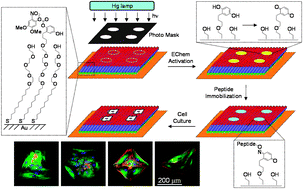A photo-electroactive surface strategy for immobilizing ligands in patterns and gradients for studies of cell polarization†‡
Abstract
We report a combined photochemical and electrochemical method to pattern ligands and cells in complex geometries and gradients on inert surfaces. This work demonstrates: (1) the control of density of immobilized ligands within overlapping photopatterns, and (2) the attached cell culture patterned onto ligand defined gradients for studies of directional cell polarity. Our approach is based on the photochemical activation of benzoquinonealkanethiols. Immobilization of aminooxy terminated ligands in selected region of the quinone monolayer resulted in patterns on the surface. This approach is unique in that the extent of photochemical deprotection, as well as ligand immobilization can be monitored and quantified by cyclic voltammetry in situ. Furthermore, complex photochemical patterns of single or multiple ligands can be routinely generated using photolithographic masks. Finally, this methodology is completely compatible with attached cell culture and we show how the subtle interplay between cell–cell interactions and underlying peptide gradient influences


 Please wait while we load your content...
Please wait while we load your content...